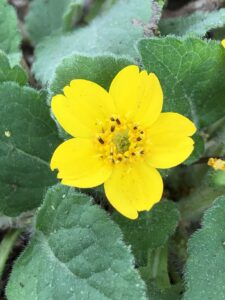Chrysogonum Virginianum (Green and Gold)
go.ncsu.edu/readext?1063776
en Español / em Português
El inglés es el idioma de control de esta página. En la medida en que haya algún conflicto entre la traducción al inglés y la traducción, el inglés prevalece.
Al hacer clic en el enlace de traducción se activa un servicio de traducción gratuito para convertir la página al español. Al igual que con cualquier traducción por Internet, la conversión no es sensible al contexto y puede que no traduzca el texto en su significado original. NC State Extension no garantiza la exactitud del texto traducido. Por favor, tenga en cuenta que algunas aplicaciones y/o servicios pueden no funcionar como se espera cuando se traducen.
Português
Inglês é o idioma de controle desta página. Na medida que haja algum conflito entre o texto original em Inglês e a tradução, o Inglês prevalece.
Ao clicar no link de tradução, um serviço gratuito de tradução será ativado para converter a página para o Português. Como em qualquer tradução pela internet, a conversão não é sensivel ao contexto e pode não ocorrer a tradução para o significado orginal. O serviço de Extensão da Carolina do Norte (NC State Extension) não garante a exatidão do texto traduzido. Por favor, observe que algumas funções ou serviços podem não funcionar como esperado após a tradução.
English
English is the controlling language of this page. To the extent there is any conflict between the English text and the translation, English controls.
Clicking on the translation link activates a free translation service to convert the page to Spanish. As with any Internet translation, the conversion is not context-sensitive and may not translate the text to its original meaning. NC State Extension does not guarantee the accuracy of the translated text. Please note that some applications and/or services may not function as expected when translated.
Collapse ▲Chrysogonum virginianum (Green & Gold)
Article by Extension Master Gardener℠ volunteer Kathryn Copley

Flower close-up (Durham County, NC)-Spring Andrea Laine CC BY-NC4.0
Green and Gold is a native, semi-evergreen, rhizom-atous, low-growing, low-maintenance perennial that typically forms an easily controlled foliage mat 1- to 2-in. tall while spreading to 18-in. wide or more.
Each yellow, daisy-like flower has five rounded, slightly-notched petals and a center tuft of yellow disk flowers. In areas with hot summers, bloom is profuse in spring and usually becomes sparse or stops in the heat of summer, with a light rebloom in fall. Flowering stems rise above the foliage mat to 8- to 10-in. tall, depending on variety. Remove spent flower stems for best ground cover appearance.
Use Green and Gold as a shady ground cover in woodland gardens, native-plant gardens or natural-ized areas where flowers attracts bees, butterflies, pollinators, and songbirds (which eat the seeds).
Three naturally occurring varieties of Chrysogonum virginianum are found in the Eastern United States, occupying slightly over-lapping regions. The northern-most variety, C. virginianum var. virginianum, is with-out stolons and not considered mat-forming. This vari-ety is also the tallest in bloom, with flowering stem height of 6 to 13 inches, and has the longest bloom time. The southern-most variety, C. virgini-anum var. australe, has the longest stolon length (5- to 24-in. long). The flowering stems are shorter — only ¾-in. to 1 ½-in. tall. The variety in the central por-tion of the range, C. virginianum var. brevistolon, has shorter stolon lengths (1- to 2½-in. long), and similar flowering stem heights to C. virginianum var. australe. The faster spreading C. virginianum var. australe will colonize larger woodland sites more quickly.
Green and Gold is easily grown in average, medium-moisture, well-drained soils high in organic matter in sun-dappled part shade to full shade. It will toler-ate full sun only if grown in consistently moist soils. Plants will need supplemental water during periods of summer drought or if exposed to afternoon sun. Plant establishment is enhanced with the addition of a slow-release, organic fertilizer mixed into the planting soil.
In the fall, propagate Green and Gold varieties that produce stolons by cutting and digging the stolons that have taken root where they touch the soil. Plants can also be propagated by division of the crown in late spring. Seedlings may be found near the base of established plants and transplanted most successfully in the fall. Seeds may be collected and sown in a fine potting mix at 70 to 75 degrees F. Germination will occur in about 3 weeks.
Green and Gold is moderately resistant to deer damage. It has no serious insect or disease problems, but there is some susceptibility to mildew. Snails and slugs may eat holes in the newer spring foliage, but damage is rarely significant.
Resources
- NC Extension Gardener Plant Toolbox: Chrysogonum repens
- NC Extension Gardener Plant Toolbox: Chrysogonum virginianum
- Home & Garden Information Center: Green & Gold
By Kathryn Copley, Extension Master Gardener SM Volunteer, Brunswick County, NC For more information on gardening in Brunswick County, please call the Brunswick County Cooperative Extension Office 910-253-2610



